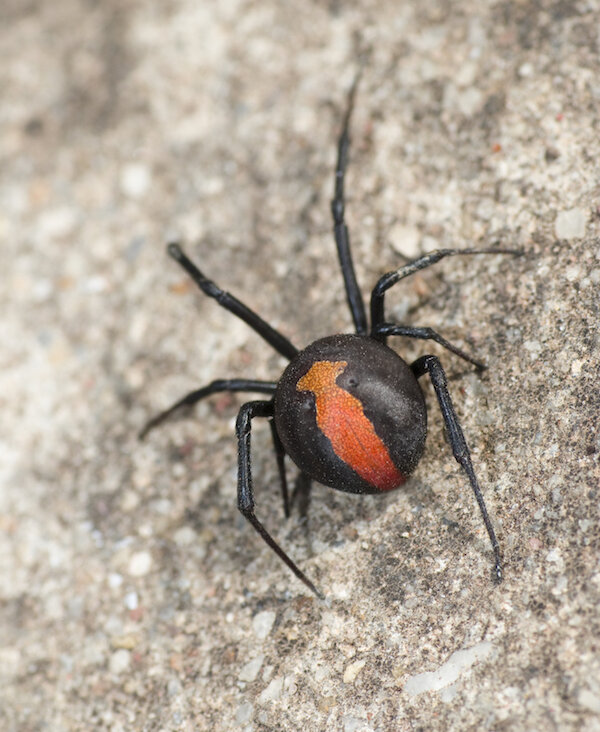Top 5 Scary Spiders on the Gold Coast
/Yes, spiders can be beneficial, keeping insect pest numbers down, but most people don’t like having spiders in and around their home. Apart from the fact their webs are unsightly, a number of spiders can give a pretty nasty bite!
Huntsman spiders are probably the most scary spider, but…
OK, so the huntsman spiders are probably the most scary spider… they are certainly big and fast moving! And sometimes they jump at you! But actually they are a bit of a softy. Unless it’s a female guarding their egg sac, they are more likely to run away. Even if they do bite, their bite is actually quite mild.
So, rather than talking about scary spiders, let’s talk about the spiders you should be scared of… the ones that give a nasty bite!
Here are the top 5 spiders on the Gold Coast that can give a nasty bite…
1) Redback spider
Female redback spider
Redback bites can be quite painful resulting in headaches, nausea, stomach pain and tiredness. Although there are around 2000 confirmed redback spider bites a year (there are probably a lot more), no one has died since the anti-venom has been introduced.
If bitten by a redback, follow the standard spider bite first aid (see below). However, it is important to seek medical advice if bitten, in case anti-venom needs to be applied.
Redback spiders tend to build their messy webs in dry sheltered areas – under logs and rocks; under BBQs, garden furniture and play equipment; in the metal tubes of tubular fencing and also in the roof void around down lights. To avoid getting bitten, wear gloves when gardening, check around BBQs, outdoor play equipment and furniture and don’t forget to look in any shoes left outdoors.
2) White-tailed spider
White-tailed spider
White-tail spider bites can be quite painful – they feel a bit like a bee sting and will become swollen and itchy.
If bitten, follow the standard spider bite first aid. Contrary to popular belief, there is no evidence that white-tail spider bites will cause flesh decay.
In nature, white-tail spiders hide under rocks, logs and underneath the bark of trees. When they come inside “by accident” or when looking for food (they eat other spiders), they tend to hide between sheets and clothes on the floor. To avoid getting bitten, wear gloves when gardening and keep your clothes off the floor!
3) Black house spider
Black house spider
The black house spider is very common around the house, but bites aren’t too common as they tend to be very timid. However, the bite can be quite painful, causing sweating, nausea and dizziness.
Follow the standard first aid if bitten and seek medical attention.
Black house spider webs are easy to spot – they are the dense funnel shaped webs often found around windows, doors and under eaves. In these locations they don’t often deliver a bite as they run into the cracks and crevices to hide when disturbed. You are more likely to get bitten whilst gardening or if crawling in the sub-floor, so wear gloves when working around the yard.
4) Trapdoor spider
Trapdoor spider
Trapdoor spiders have a bite which is painful initially but the pain subsides. Although visually similar to a funnel web spider to the untrained eye and often confused with the funnel-web as they live in web-lined burrows, the bite symptoms are quite different and not life-threatening.
Treat trapdoor spider bites with the standard spider first aid. However, if you are not confident with the identification of the spider, seek medical assistance.
Trapdoor spiders will commonly be found in gardens. They don’t always have a trapdoor on their burrows, but their burrows are lined with webs. Wear gloves when gardening to avoid being bitten.
5) Tree-dwelling funnel web spider
Tree dwelling funnel web spider (credit: Toby Hudson (Wikimedia Commons))
Although not as well-known as its Sydney relative – the Sydney funnel web spider – the bite of the Northern tree funnel-web spider is just as dangerous. The bite is extremely painful and results in profuse sweating, raised heart rate and blood pressure, muscle spasms, nausea and vomiting.
If you suspect being bitten by a funnel web seek immediate medical attention. The patient needs to be kept still and the bite should be treated in a similar fashion to a snake bite – immobilise the limb and apply a pressure bandage. The good news is that since the anti-venom was developed back in the 1980s there have been no deaths from funnel-web bites.
Fortunately bites from the tree dwelling funnel-web are quite rare, as it is not encountered very often. Generally it is found only in the hinterland, living in holes in tree or fallen logs.
Spider bites - Spider identification
Obviously not everyone is a spider expert and often you don’t get to see what’s bitten you. If you cannot catch the spider safely (it’s often best to sit down and carry out first aid rather than catch the spider), take a photo for later identification.
Recommended spider bite first aid
· The bite victim should sit down and stay calm
· Clean the bite with water and disinfectant
· Apply an ice pack to the bite area to relieve the pain
· Seek medical attention if a redback spider bite is suspected or if the pain persists and gets worse.
For funnel-web spider bites, treat the patient as per a snake bite – get the patient to sit down, immobilise the bitten limb with a pressure bandage and call for medical help immediately.
Of course Gold Coast Pest Services can provide professional spider treatments if you have a particular spider problem or if you want to minimise the chances of a spider entering your home.










